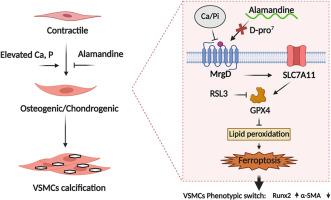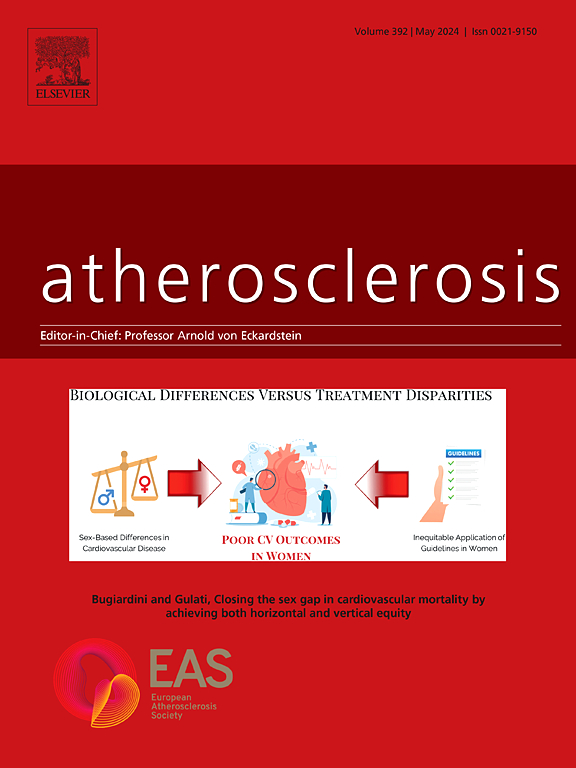Alamandine通过抑制铁下垂抑制血管钙化
IF 5.7
2区 医学
Q1 CARDIAC & CARDIOVASCULAR SYSTEMS
引用次数: 0
摘要
背景和目的血管钙化常见于慢性肾脏疾病(CKD)、糖尿病和动脉粥样硬化的病理过程,它增加了心脏不良事件的风险。近年来的研究表明,Alamandine (ALA)/mas相关G蛋白偶联受体D (MrgD)是非规范肾素-血管紧张素系统(RAS)的一个轴,对心血管系统有有益的作用。然而,尚不清楚它是否能防止血管钙化。方法采用高磷酸盐和高钙诱导血管平滑肌细胞钙化,维生素D3诱导小鼠主动脉钙化模型。采用茜素红染色和钙含量测定法评价钙化程度。Western blot检测蛋白表达水平。结果胸椎钙化患者血清sala水平明显低于正常对照组。高钙高磷酸盐诱导VSMCs钙化。ALA处理可抑制VSMC钙化,阻断受体MrgD可消除ALA对VSMC钙化的抑制作用。与此一致,ALA/MrgD在体外显著减弱大鼠和人动脉环的钙化,在体内抑制小鼠主动脉的钙化。在机制上,VSMC钙化伴随着铁下垂的发生,表现为细胞死亡增加,活性氧(ROS)和丙二醛(MDA)水平升高,铁下垂抑制信号分子SLC7A11和谷胱甘肽过氧化物酶4 (GPX4)表达降低。此外,ras -选择性致死3 (RSL3)对GPX4的抑制加剧了成骨条件下VSMCs的钙化。值得注意的是,ALA拮抗rsl3诱导的VSMC钙化,提示ALA通过抑制铁下垂来减弱VSMC钙化。结论本研究首次发现ALA/MrgD抑制成骨状态下VSMC钙化和vitd3超载小鼠主动脉钙化。此外,我们发现ALA/MrgD通过调节铁下垂抑制血管钙化。这些发现为治疗血管钙化提供了一种新的靶向策略。本文章由计算机程序翻译,如有差异,请以英文原文为准。

Alamandine suppresses vascular calcification through inhibition of ferroptosis
Background and aims
Vascular calcification is commonly found in pathological processes of chronic kidney disease (CKD), diabetes and atherosclerosis, which increases the risk of adverse cardiac events. Recent studies have shown that Alamandine (ALA)/mas associated G protein coupled receptor D (MrgD), an axis of noncanonical renin-angiotensin system (RAS), exerts beneficial effects on cardiovascular systems. However, it is still unclear whether it protects against vascular calcification.
Methods
High phosphate and calcium were used to induce calcification of vascular smooth muscle cells (VSMCs) and mouse model of aortic calcification was induced by vitamin D3. Alizarin red staining and calcium content assay were used to assess calcification. Western blot analysis was used to examine the protein expression levels.
Results
ALA serum levels were significantly lower in patients with thoracic calcification compared to healthy controls. High calcium and phosphate induced calcification of VSMCs. ALA treatment inhibited VSMC calcification and blockage of receptor MrgD abrogated the inhibitory effect of ALA on VSMC calcification. Consistently, ALA/MrgD significantly attenuated calcification of rat and human arterial rings ex vivo, and inhibited mouse aortic calcification in vivo. Mechanistically, VSMC calcification was accompanied by the occurrence of ferroptosis as indicated by increased cell death, increased levels of reactive oxygen species (ROS) and malondialdehyde (MDA), and decreased expression of ferroptosis inhibition signaling molecules SLC7A11 and glutathione peroxidase 4 (GPX4). Furthermore, inhibition of GPX4 by RAS-selective lethal 3 (RSL3) exacerbated calcification of VSMCs under osteogenic conditions. Of note, ALA antagonized RSL3-induced VSMC calcification, suggesting ALA attenuated VSMCs calcification through inhibiting ferroptosis.
Conclusions
our study for the first time revealed that ALA/MrgD suppressed VSMC calcification under osteogenic condition and aortic calcification in VitD3-overloaded mice. Moreover, we unveiled that ALA/MrgD inhibited vascular calcification via modulation of ferroptosis. These findings present a novel targeting strategy for the treatment of vascular calcification.
求助全文
通过发布文献求助,成功后即可免费获取论文全文。
去求助
来源期刊

Atherosclerosis
医学-外周血管病
CiteScore
9.80
自引率
3.80%
发文量
1269
审稿时长
36 days
期刊介绍:
Atherosclerosis has an open access mirror journal Atherosclerosis: X, sharing the same aims and scope, editorial team, submission system and rigorous peer review.
Atherosclerosis brings together, from all sources, papers concerned with investigation on atherosclerosis, its risk factors and clinical manifestations. Atherosclerosis covers basic and translational, clinical and population research approaches to arterial and vascular biology and disease, as well as their risk factors including: disturbances of lipid and lipoprotein metabolism, diabetes and hypertension, thrombosis, and inflammation. The Editors are interested in original or review papers dealing with the pathogenesis, environmental, genetic and epigenetic basis, diagnosis or treatment of atherosclerosis and related diseases as well as their risk factors.
 求助内容:
求助内容: 应助结果提醒方式:
应助结果提醒方式:


